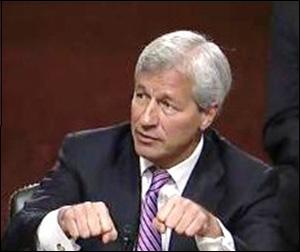By Pam Martens and Russ Martens: June 15, 2015
The U.S. Treasury’s Office of Financial Research (OFR), the body created under the Dodd-Frank financial reform legislation to make sure another 2008 epic crash never happened again, quietly released a report last week which not only suggests another 2008-style crash is possible but that regulators will likely be blindsided again.
The report, written by Jill Cetina, John McDonough, and Sriram Rajan, reveals that the big Wall Street banks are ginning up their capital measures by engaging in opaque and potentially dangerous “capital relief trades.”
To illustrate how dangerous this kind of capital relief arbitrage can be, the report says that JPMorgan’s London Whale trades (which blew a $6.2 billion hole in the insured bank) was a capital relief trade.
Here’s the precise language from the report:
“JPMorgan Chase & Co.’s losses in the 2012 London Whale case were the result of CDS [Credit Default Swap] usage which was undertaken to obtain regulatory capital relief on positions in the trading book.”
That analysis stands in stark contrast to Jamie Dimon’s testimony on the London Whale before the Senate Banking Committee on June 13, 2012. Dimon told the Committee that the London Whale trades were to “hedge the company against a systemic event, like the financial crisis or Eurozone situation. Among the largest risks we have as a bank are the potential credit losses we could incur from the loans we make.”
While few people actually believed Dimon’s version of what was going on, it was more widely believed that this was simply high-risk proprietary trading that JPMorgan did not want to admit to because it was occurring in its insured bank rather than its investment bank using its own capital.
The focus on opaque capital relief trades by the biggest Wall Street banks has been an outgrowth of regulators demanding that the mega banks hold more capital to protect them from potential losses that could once again spill over into a taxpayer bailout. Regulators allow banks to calculate their regulatory capital under a risk-based formula that requires more capital for riskier assets and loans and less capital for safer ones. The OFR report gives the following example as to how a bank can window-dress its capital ratio:
“To see how a bank can structure regulatory capital relief, let’s look at a hypothetical bank required to hold capital equal to 8 percent of its total risk-weighted assets. A relatively safe asset held by a bank might be assigned a 100 percent risk weight, requiring 8 cents of capital for every dollar of the asset. A more risky loan is assigned a 750 percent risk weight, requiring 60 cents of capital for every dollar of the asset. A bank’s riskiest assets are assigned a 1,250 percent risk weight, requiring one dollar of capital to back every dollar of the asset (8 percent times 1,250 percent = 100 percent).
“The same bank can reduce its regulatory capital by purchasing credit protection. For example, suppose that the bank wants to reduce the $60 of regulatory capital it must hold against a specific $100 loan that has a 750 percent risk weight. The bank buys CDS protection from a hedge fund for the full value of the $100 loan. That transaction allows the bank to substitute the 750 percent risk weight on the loan with a lower 100 percent risk weight assigned to the counterparty credit risk of the hedge fund that sold the credit protection. The difference in the risk weighting means the bank now must hold only $8 in regulatory capital against the same $100 loan…”
Unfortunately, according to the OFR report, regulators, the public and shareholders are flying blind when it comes to these capital relief trades. The OFR writes:
“Relatively little data are available about U.S. banks’ regulatory capital relief transactions, the financial strength of nonbank counterparties selling the credit protection, and the impact of those trades…Although banks are required to report their use of some forms of credit protection to obtain capital relief, even instances where they do report, banks do not have to disclose the effect of these transactions on their risk-weighted assets and capital ratios. Without that information, it is difficult for investors and counterparties to know the effect of these transactions on a bank’s risk.”
The report further notes that there is “limited counterparty information available to bank supervisors when a bank turns to a hedge fund, private equity firm, or other nonbank to buy credit protection, since those companies are outside the jurisdiction of bank supervisors.”
Let that sink in for a few seconds: some of the most dangerous Wall Street banks on the planet are able to dodge their capital requirements by buying protection from even more dangerous, unsupervised hedge funds.
Welcome to the new, new world of financial reform.


